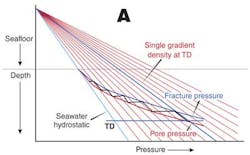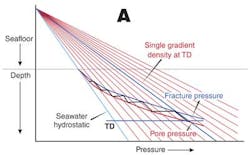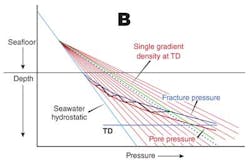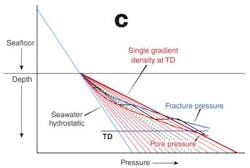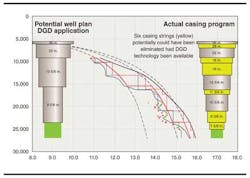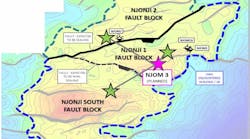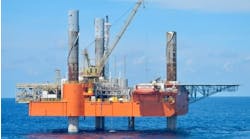Dick Ghiselin
Special Correspondent
For more than two decades, the oil and gas industry has invested millions of dollars and thousands of man-hours to develop a solution to a looming challenge affecting the ability to drill and complete deep wells. Felt most acutely in deepwater development drilling, the challenge actually applies to all deep drilling applications. In a nutshell, the problem is that in formations with narrow drilling margins, no matter how big the surface hole is, by the time the bit reaches total depth, there is scant room for an efficient, productive completion to be deployed because of the multiple protective casing strings, each of decreasing diameter.
More than once, experts have declared prospective boreholes to be "undrillable" because mud weights needed to contain formation fluids approached the formation matrix failure point. The difference between the two limits is called the drilling margin, and the limits typically are defined as the pore pressure gradient and the fracture pressure gradient.
The best way to view this is graphically, says Chevron's Ken Smith. Typically, when drilling fluid is weighted up to apply the optimal pressure at total depth in a deepwater scenario, the hydrostatic pressure at the mudline is already significantly higher than the shallow sediments at the seabed can tolerate. The result is that several casing strings must be set before reaching total depth.
With a typical narrow drilling margin, a single-gradient drilling fluid well design could necessitate five or more casing points. However, if it were possible to introduce and maintain a dual-gradient drilling (DGD) fluid, the same well could be drilled with only three or four casing points. In fact, reducing the wellbore hydrostatic pressure at the mudline to that of seawater is the equivalent of removing the sea from the equation and drilling as if the rig was sitting on the seabed. The effect would be to equate offshore drilling with onshore drilling as regards staying within the drilling margin.
This simple explanation becomes more complex and difficult when applied to actual deep well conditions. Starting with identical 36-in. conductor pipe, two wells targeting a formation lying at 25,000 ft (7,620 m)—one drilled using dual-gradient drilling, the other drilled conventionally using single gradient drilling—can be compared. A safe drilling margin with single-gradient fluid could require as many as six extra casing strings. Moreover, the borehole diameter at the bottom would be barely large enough to accommodate a simple completion, much less a complex one, and well productivity could suffer.
A formidable challenge
One might ask, "Why did it take decades for the industry to come up with this solution?" The answer was supplied by Transocean's John Kozicz. "We are an industry that seems to be energized by the word can't," he said. "We try to solve our problems traditionally until someone tells us something can't be done. Then we apply ourselves and do it."
Smith agreed: "With as many as nine concentric strings of casing in some wells, we were just about against the wall."
Kozicz and Smith each leads his company's efforts to deploy dual-gradient drilling. Interestingly, they are following different paths.
The concept of dual-gradient drilling was proven viable in a joint industry project launched in 1996, and culminating with a successful trial on Texaco's Shasta prospect in Green Canyon block 136, US Gulf of Mexico. In August of 2001, the DiamondNew Era semisubmersible drilling unit deployed the first seabed mudlift system, the key element in establishing a dual hydrostatic gradient condition. Although the water depth was less than 1,000 ft (305 m), the concept worked. Static bottomhole pressure and equivalent circulating density (ECD) could be controlled as required to maintain a safe drilling margin without exposing shallow unconsolidated sediments to fracture pressures, or risking undesired influx of formation fluids.
One big hurdle to making the system commercial was to develop a reliable seabed mud pump that could safely cover all potential situations. Not only were mechanical and hydraulic reliability critical, but the actual pump design and materials were thoroughly explored to ensure the best solution could be deployed.
Trying to anticipate every possible operating situation was a major challenge. One big boost to the vetting process was a simulator developed under the direction of Hans Juvkam-Wold and Jerome Schubert of Texas A&M University. Using the simulator, each of some 25 drilling procedures could be tested and evaluated in the new environment. In addition to vetting the physical characteristics of suggested designs, the simulator allowed developers to include the critical human component. The objective was to develop a system that satisfied all the operational and safety requirements and constraints, but also was as uncomplicated as possible. Training rig crews to operate the equipment under all possible well and drilling conditions was a formidable challenge—possibly the most important one of all.
Development of the procedures used in the dual-gradient drilling environment required 12 to 15 man-years of work. First, the team had to realize that not every technique they used before necessarily worked the same in dual-gradient drilling. Some challenges were obvious, such as how to prevent u-tubing of the heavy mud when pipe joints were broken out to make a connection. Others, like how to manage two fluids while tripping the pipe, required both hydro-mechanical and human-engineering solutions.
The seabed pumping DGD system has three primary elements: the mudlift pump (MLP), the solids processing unit (SPU) to keep the cuttings size within the MLP specifications, and the subsea rotating device (SRD) which is a mechanical barrier between the fluid in the riser and the drilling mud in the well. It also allows drillers to quickly adjust annular pressure for MPD purposes, and it reduces the chance of gas ingress into the drilling riser. All of this is installed atop the BOP and lower marine riser package (LMRP). Installation is performed in the rig's moonpool and then the assembly with its subsea pumps is deployed and landed on the wellhead flange.
A fork in the road
While the industry was working to commercialize dual-gradient drilling, diversity of opinion arose. While several versions of the seabed pumping system had been proposed and some were in advanced stages of testing, a different approach was suggested. Called Continuous Annular Pressure Management (CAPM), the technique consists of injecting diluted drilling fluid into the riser at or near the seabed to reduce hydrostatic pressure at the mudline. While not producing as great an effect as the seabed pumping system, which resulted in the riser annulus being totally filled with the equivalent of seawater, the CAPM system has one major advantage – all equipment is on the rig where it can be easily monitored and maintained. There are no seabed pumps.
The CAPM technique is being independently pursued by Transocean, as a possible alternative. Both systems have their advantages.
The principle of CAPM recognizes that drilling fluid generally consists of two components: a base fluid – oil or water or some synthetic material – and a weighting material – usually barite or hematite. Typically, when mud returns to the rig it passes through the shale shaker to remove cuttings, a degasser, and perhaps a desander on its way back to the suction pit. If the returns could pass through a battery of centrifuges, the weighting material could be partially separated from the base fluid, leaving dual fluids – one at typically 8-9 ppg, and the other at typically 16 ppg. Subsequently, using a closed loop system, the heavy fluid is recirculated to the bit while the lighter fluid is re-injected into the riser annulus at or near the seabed. The effect is almost the same as that of the seabed pumping process. Hydrostatic pressure at the mudline is equal to or slightly greater than that of seawater.
The CAPM system components are modular and can be deployed on any rig, including, according to Kozicz, a land rig. This could have major implications as land rigs attempt ultra-deep wells in formations with narrow drilling margins.
Transocean came to its position by observing the advantages of managed pressure drilling (MPD) where the company was able to better understand wellbore conditions, achieve early detection of ballooning or influx, and experience less non-productive time (NPT). Says Kozicz: "We observed that we were able to make informed decisions faster in a closed loop environment, and the reductions in NPT alone offset the added expense of the equipment. The elimination of unnecessary casing strings just added to the inducement to pursue the CAPM technique."
Future developments include pursuit of techniques that will allow the diluent light drilling fluid to be injected below the mudline. This would have the effect of creating a virtual seabed hydrostatic pressure that is actually less than seawater.
Playing by the rules
"We are initially planning to deploy our dual-gradient technique on the newPacific Santa Ana, high specification drillship," Smith continued. "In our view, the biggest advantages will be realized in wells where downhole uncertainties are the greatest or where the known pressure margins are the tightest."
Kozicz agreed, but added, "As a contract driller, Transocean has to be sensitive to the needs of its customers. Accordingly, we want to be prepared to offer the dual-gradient technique preferred by our customers, not solely the CAPM technique."
Even though the CAPM equipment is modular and technically portable, Kozicz does not see Transocean moving it from rig to rig without full planning. "It still takes about a month of shipyard time to equip a rig for CAPM, and that requires evaluating all the costs and benefits," he said.
Each said his company is proceeding systematically and meticulously in two critical areas: training and regulatory compliance. Smith said, "We will run approximately 150 people through up to 13 days of training, including a week of advanced well control. We find that even experienced drilling personnel require a few months of 'soak-in time' for the new concept to gel, but then everything starts to fall into place."
To satisfy the requirements of the regulatory authorities, both men agreed that each step is being thoroughly reviewed and permitted by the Bureau of Safety and Environmental Enforcement (BSEE). Third-party certified verification agents are being used. These experts are also going through the training courses and witnessing drilling procedures under the new systems. In both cases, International Association of Drilling Contractors accreditation also must be obtained.
Separately, both Chevron and Transocean look to perform their first dual-gradient drilling job. ThePacific Santa Ana is equipped and ready for Chevron to perform its first dual-gradient drilling job, expected near year-end. Transocean has deployed CAPM on its Deepwater Enterprise high specification drillship and is seeking a contract.
Many similarities
While the two systems have definite differences, many components and procedures are similar.
For example, both systems use a downhole flow-stop valve (FSV). This pressure operated valve in the bottomhole assembly prevents the heavy drilling fluid from u-tubing every time a connection is made up or broken out. Procedures are in place to deal with failure of the FSV, should one occur. Both systems accommodate mud pulse telemetry technology so there is compatibility with measurement/logging-while-drilling (MWD/LWD) services. In fact, Kozicz said that LWD deployment is nearly universal in deepwater wells. This equipment provides important real time parameters in dual-gradient drilling – annular pressure and vibration – so drillers have nearly instant knowledge of ECD.
No matter which system is used, operators benefit from having more room to work with in terms of bottomhole casing diameter when designing and deploying completion hardware. This can have a significant effect on well productivity and ease of workover activities.
Both systems have user-friendly drillers' displays that are uncomplicated and intuitive. Drillers find that after familiarization and a few trial runs on the simulator, they are confident in being able to operate in the new drilling environment.
The long-awaited "holy grail" of deepwater drilling is within reach. It is likely that the final decision on which technique is best will depend on the situation. Both have individual advantages, but both in common offer dividends to deepwater operators in terms of improved drilling efficiency, lower costs, and easier completions.
Offshore Articles Archives
View Oil and Gas Articles on PennEnergy.com
